fall inside a hole
Plarail Joint Rails
First written March 28, 2024Joint Rail (ジョイントレール)/J-10 Joint Rail (R-10 ジョイントレール) (early 1960s-1997)
| <-- R-09 Reciprocating Return Rail | R-11 Turnout Rail --> |
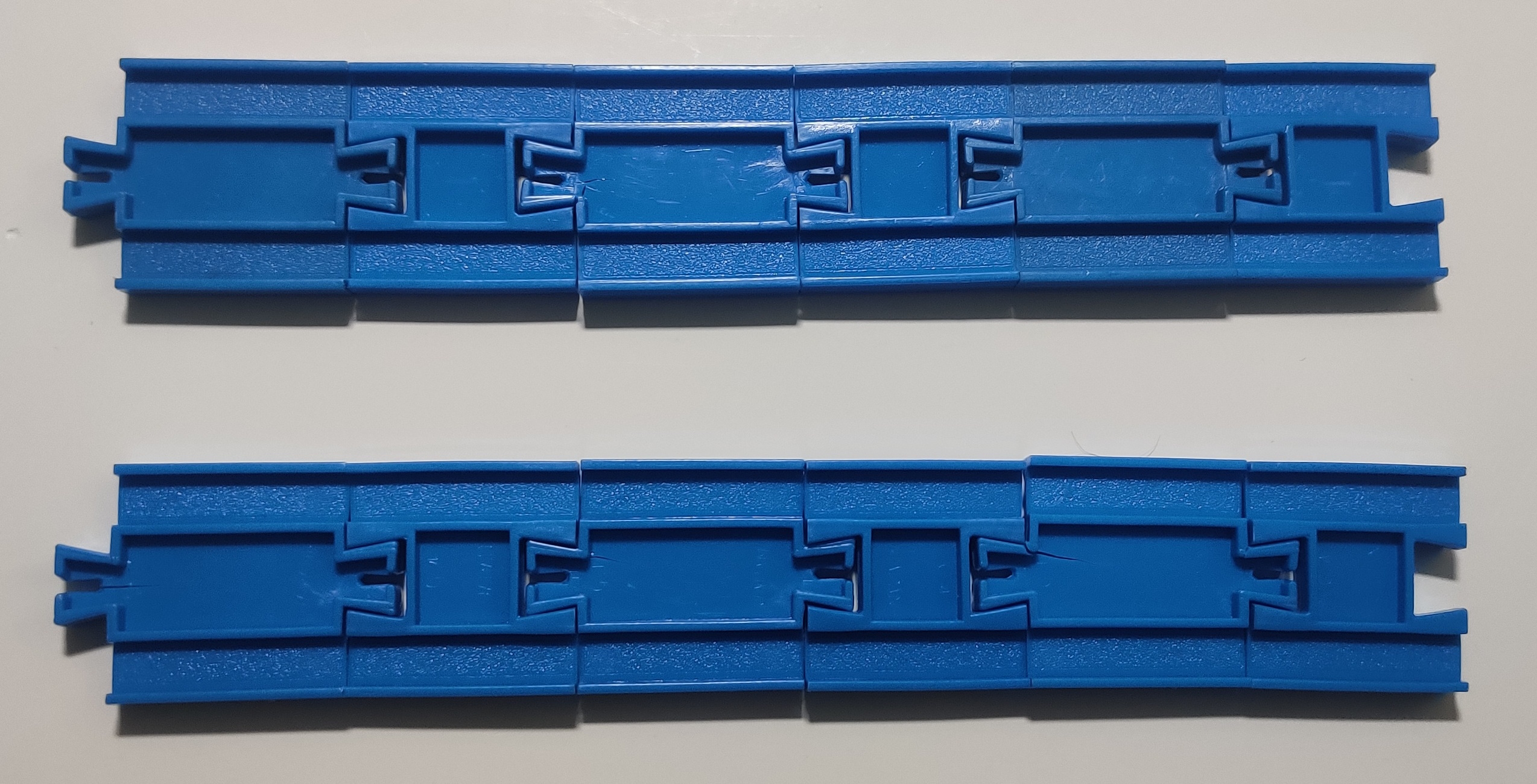
Joint Rails (ジョイントレール) serve to switch the configuration of the track joints from concave to convex or vise-versa. Because the Plarail rail standard has an asymmetric connection joint, a "joint rail" is required to be able to make complex layouts. Each joint rail measures approximately 36mm long, which is close to 1/6th of a standard straight rail (~216mm). Occasionally, these rails are referred to as 1/6 rails, although there was never a true "straight" rail, only double concave and convex sections. An ~1/6 straight can be made with a double concave piece and a bean double-convex zero-track-length piece.
The earliest joint rails were included with sets in the early 1960s and were completely smooth. By the early 1970s a pack of 12 joint rails, six of each type, was on sale. This was number 25 under the 1970s numbering scheme and later became R-15 in 1988 under the modern numbering scheme.
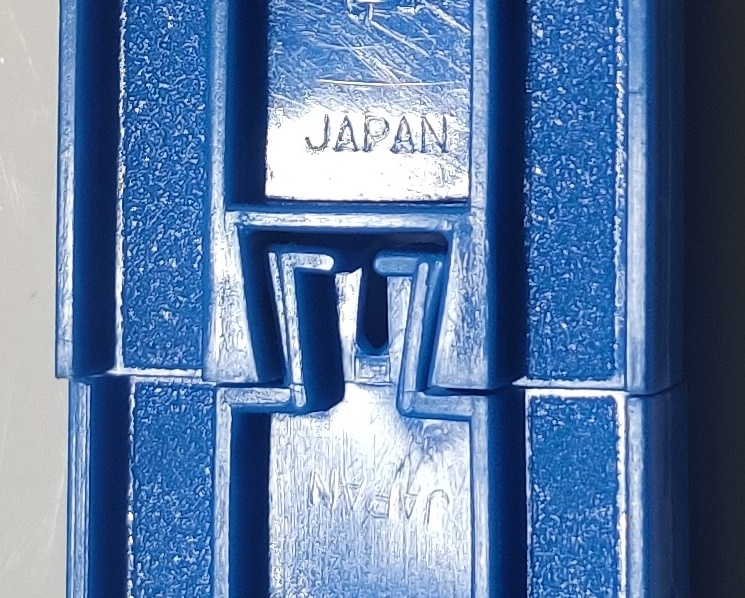
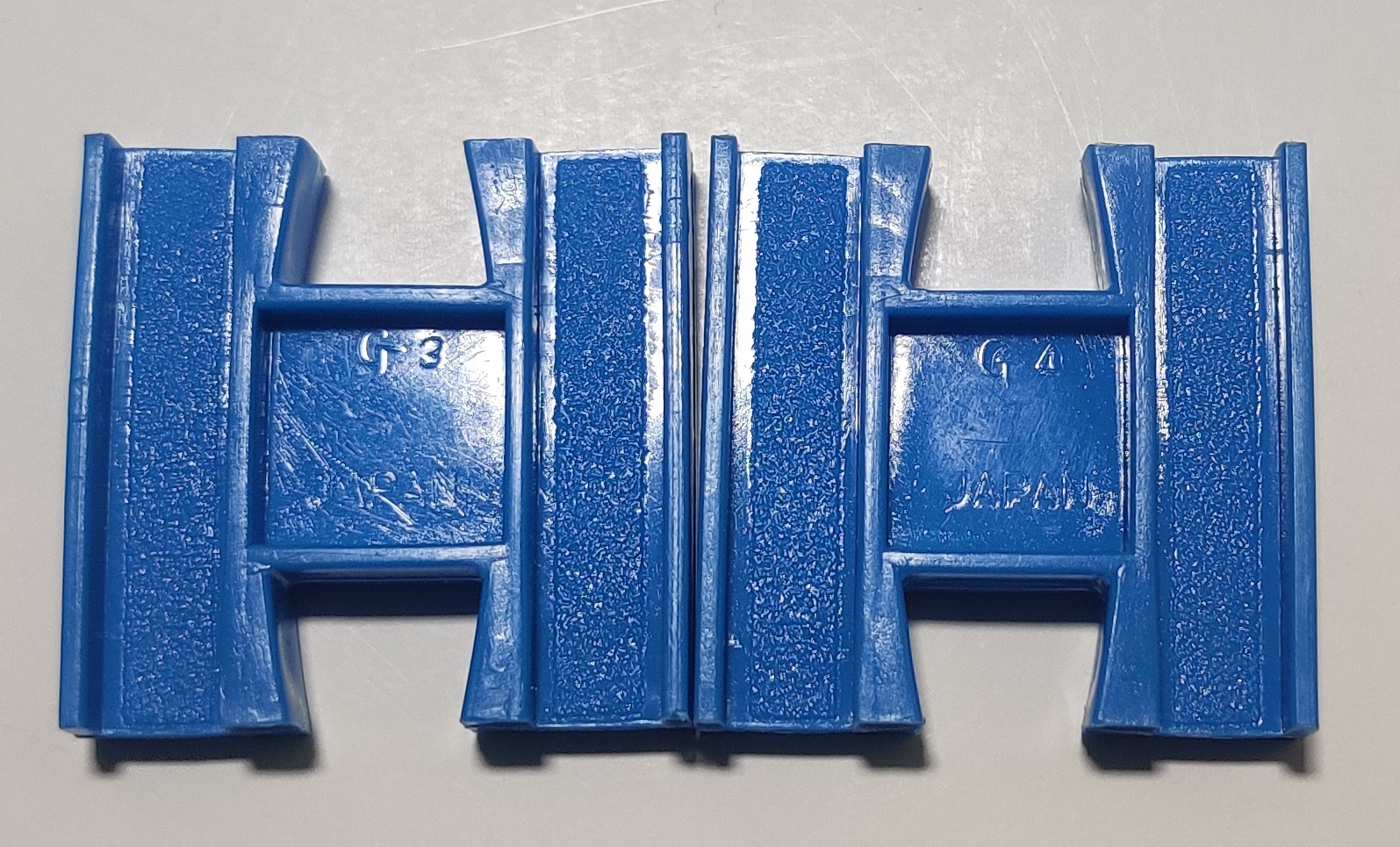
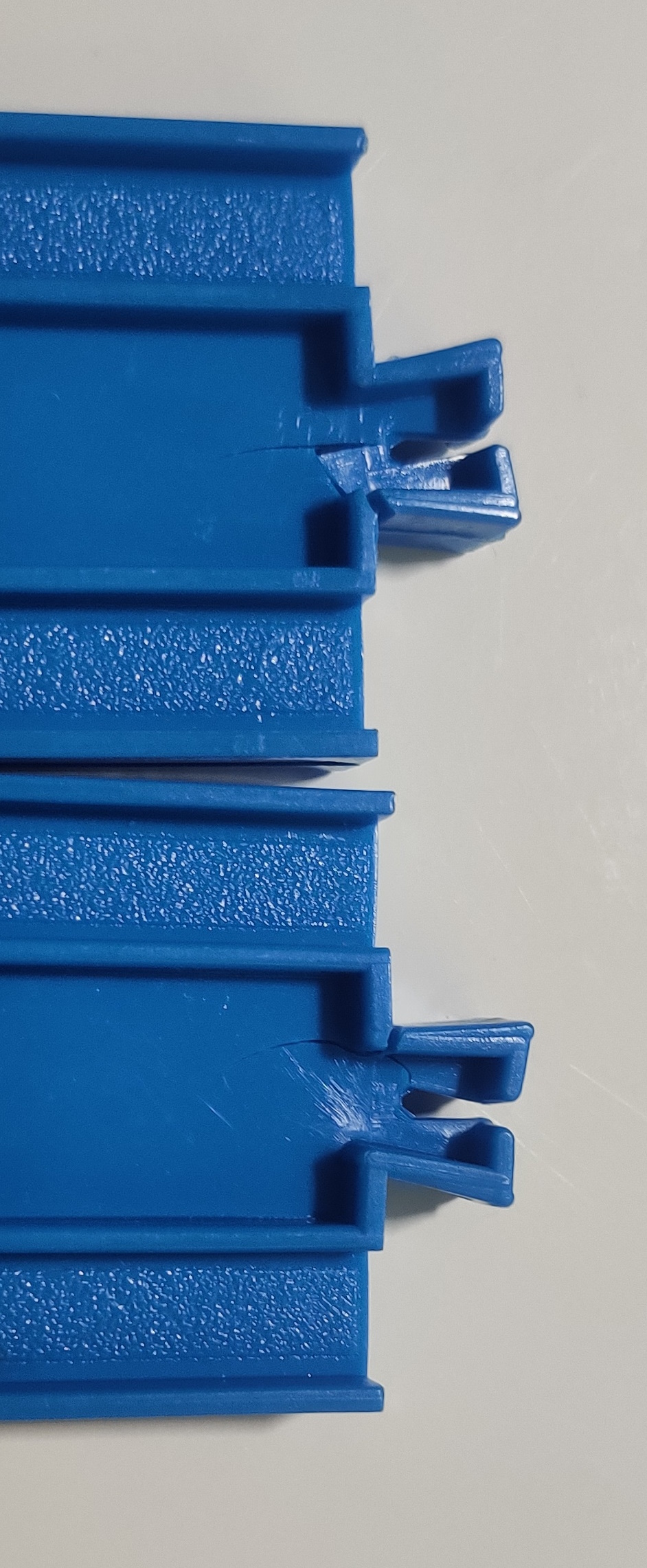
When rails transitioned to roughtop tread in 1974 the joint rails gained a roughened rail surface. Joint rails from the mid 1970s up to the late 1980s were all made in Japan in this style. The convex connectors on these short rails seem particularly prone to cracking and splitting with age, and appear to shrink and expand unevenly. I also somewhat suspect that even at the time these early joint rails were somewhat oddly fitting.
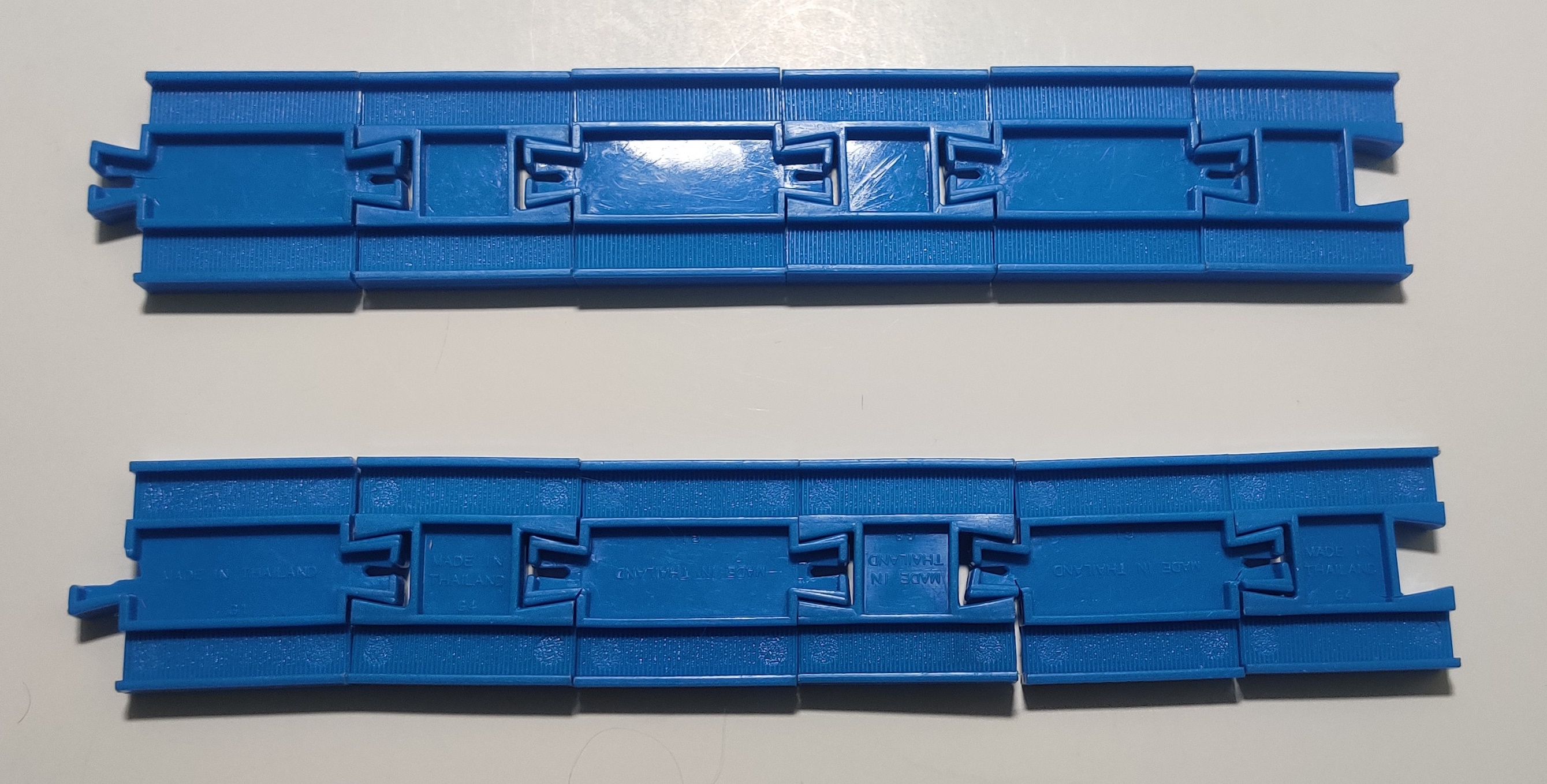
Around 1990 joint rail production moved to Tomy's new Thailand factory. These early 1990s Thailand joint rails have the new treaded surface applied over the roughtop surface already present in the tooling.
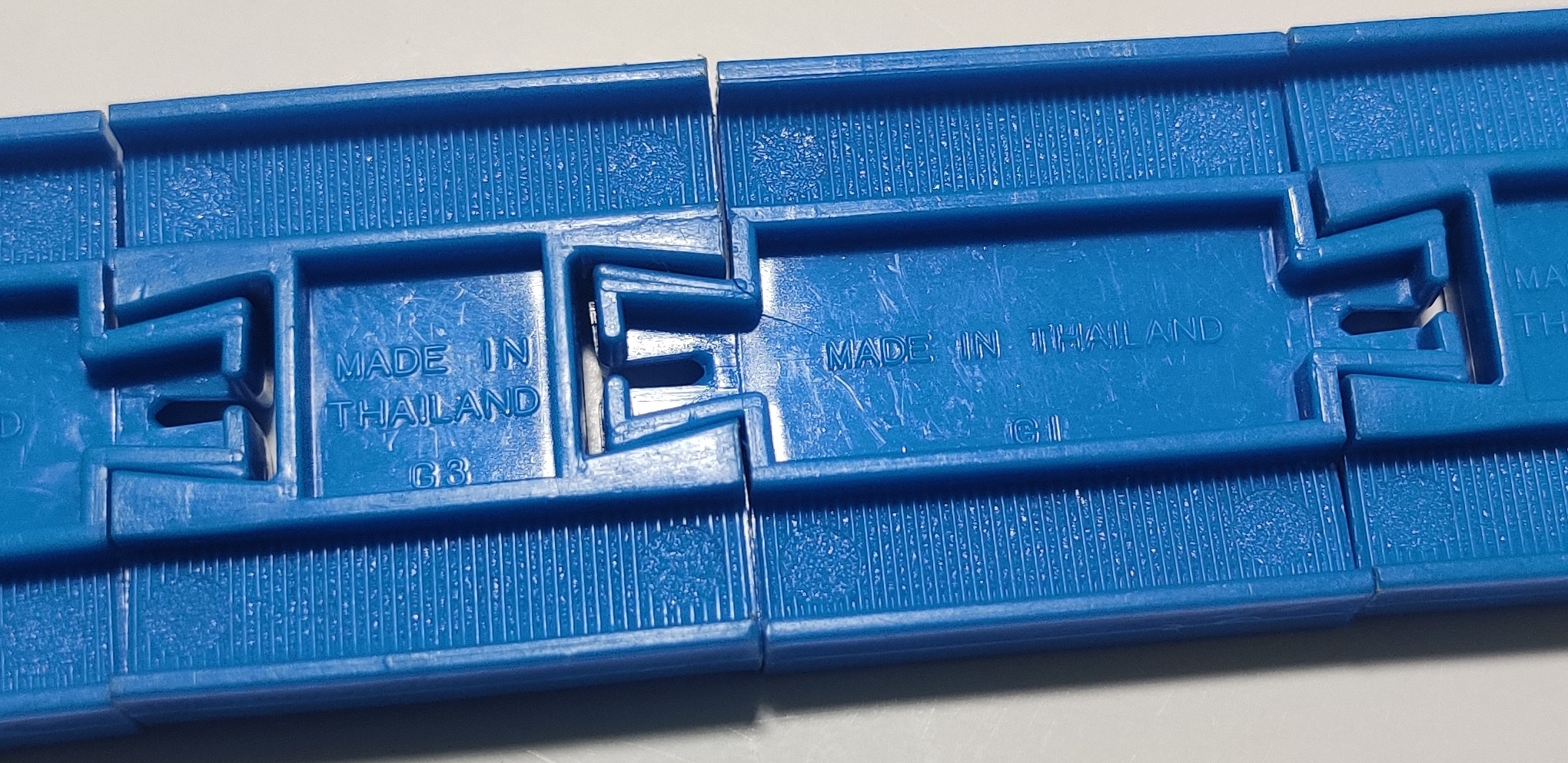
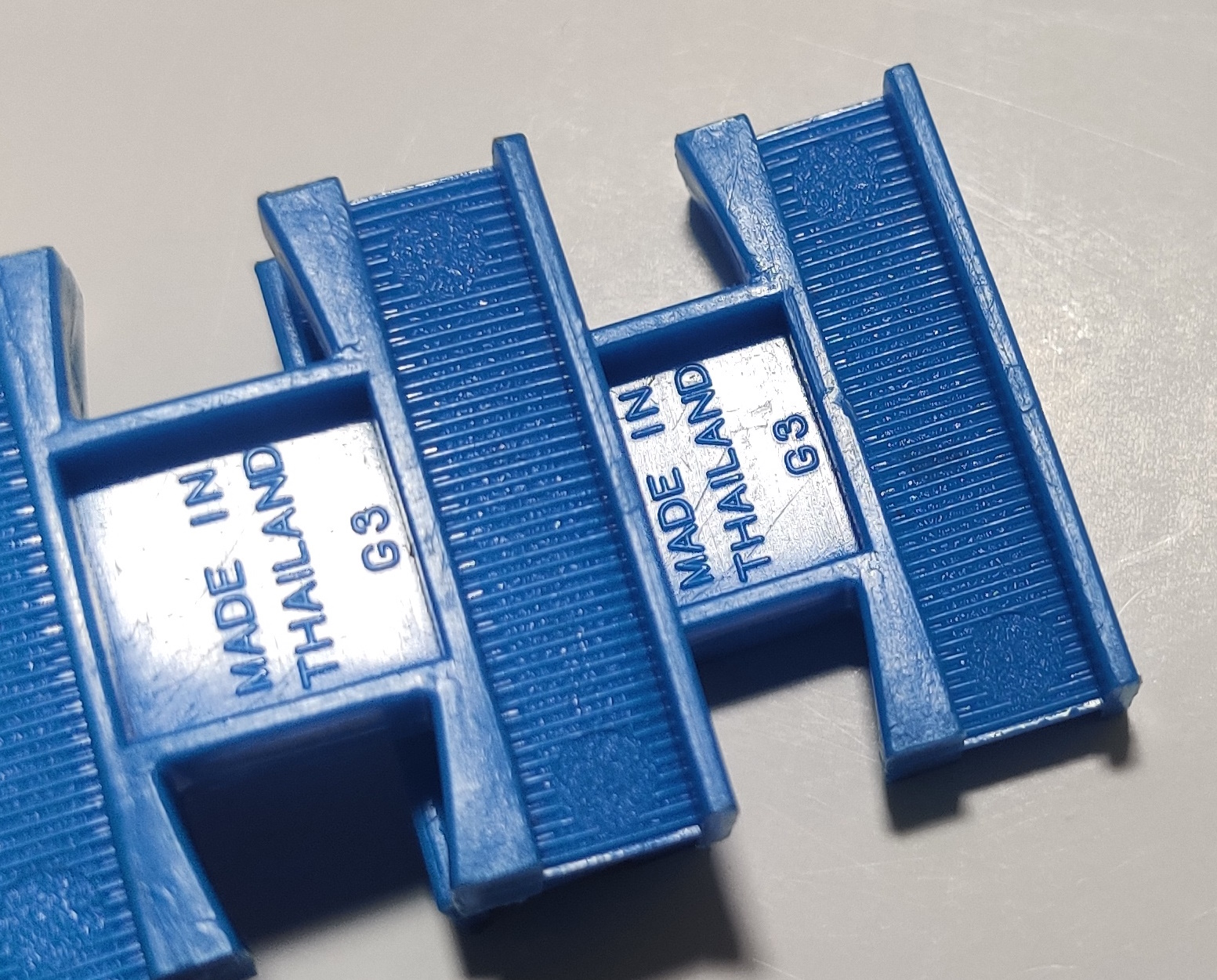
These joint rails are still fairly fragile on the convex connector.
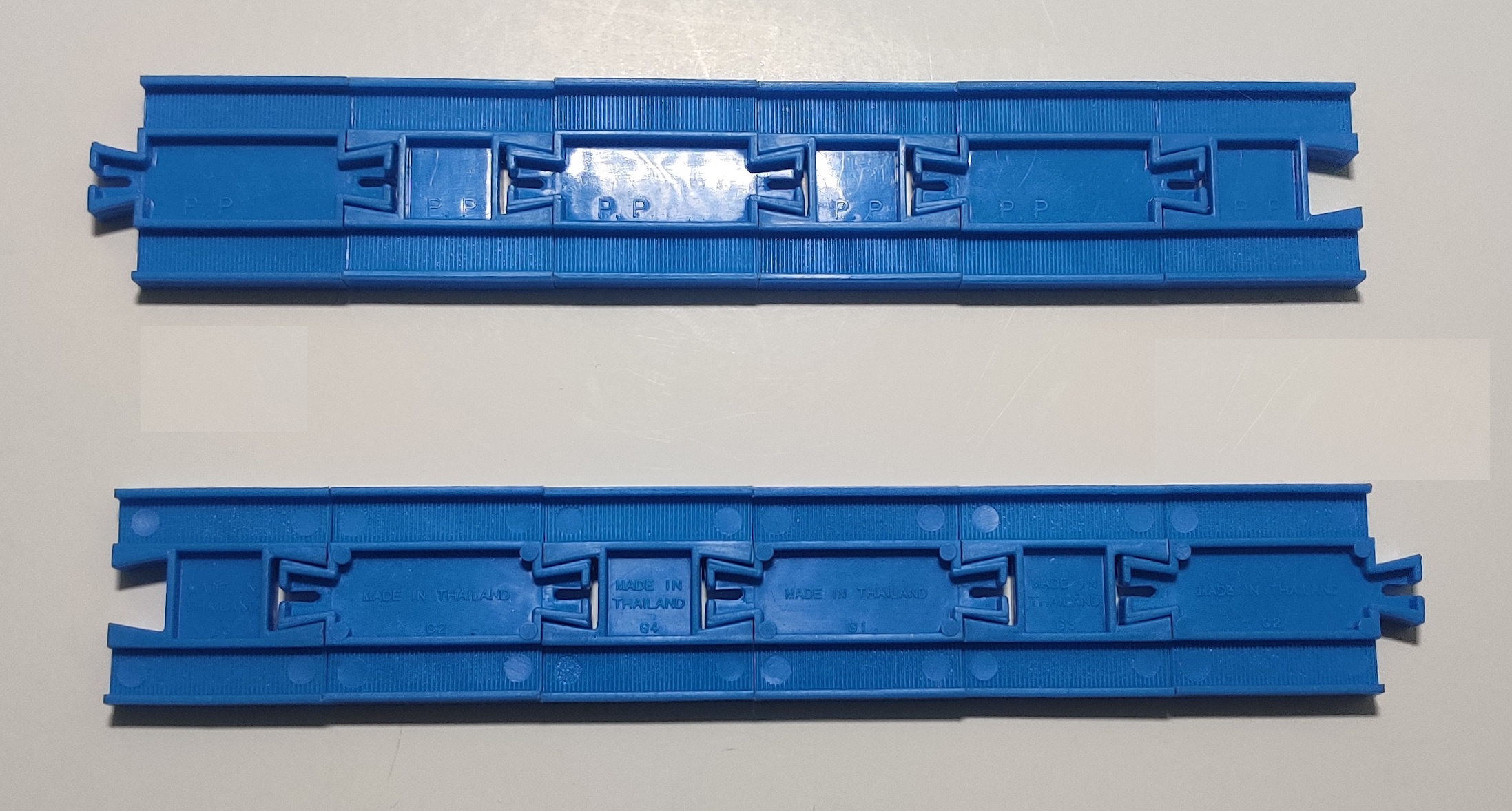
The nicest and best-surviving joint rails are later 1990s production Thailand joint rails with the "P.P." mark. These appear to be a fresh or refreshed tooling with nicer treads and joints. They have similar Thailand and molding slot marks on the bottom but with flat round molding marks instead of roughtop treaded ones like the previous Thailand production style.
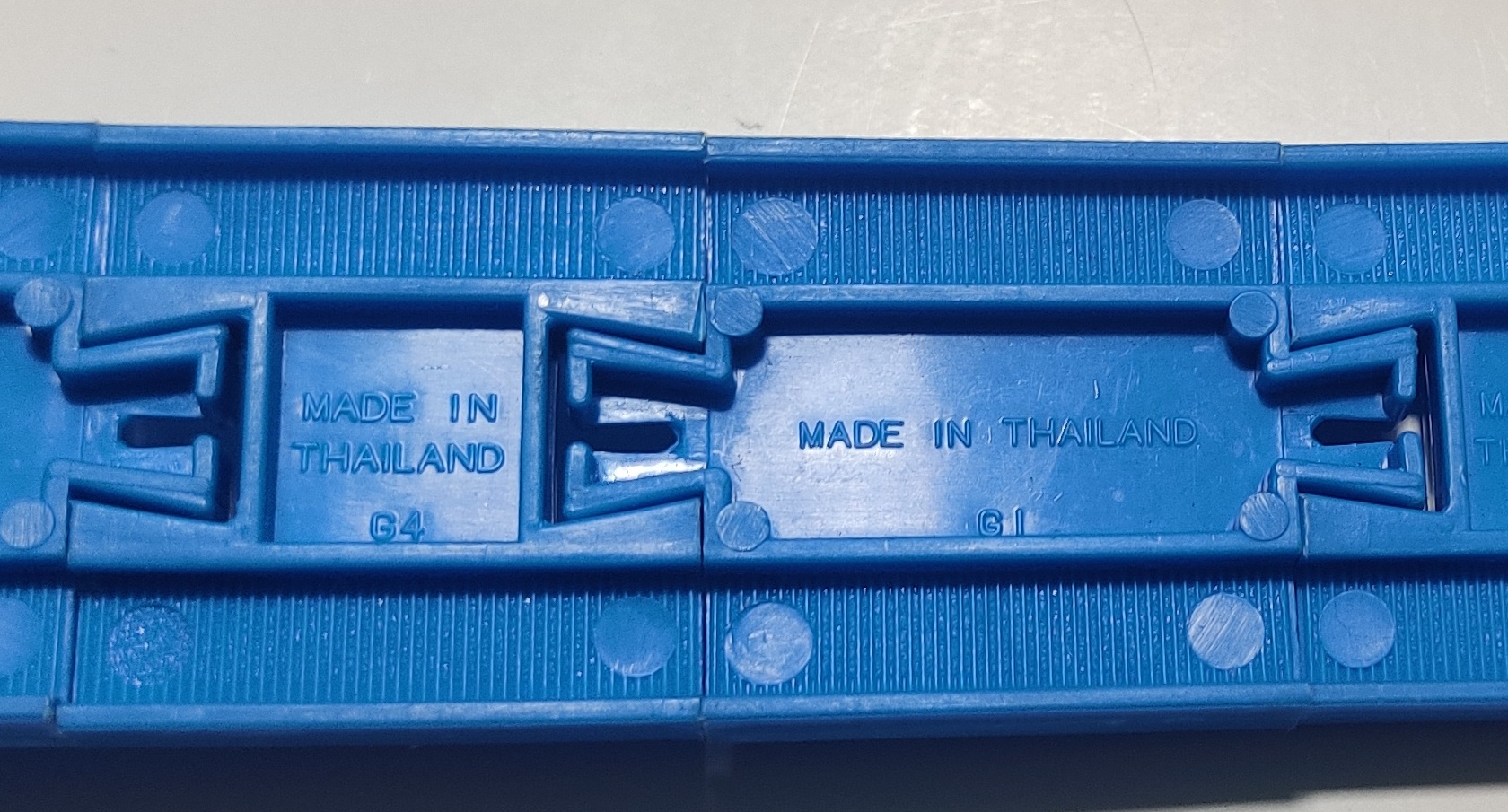
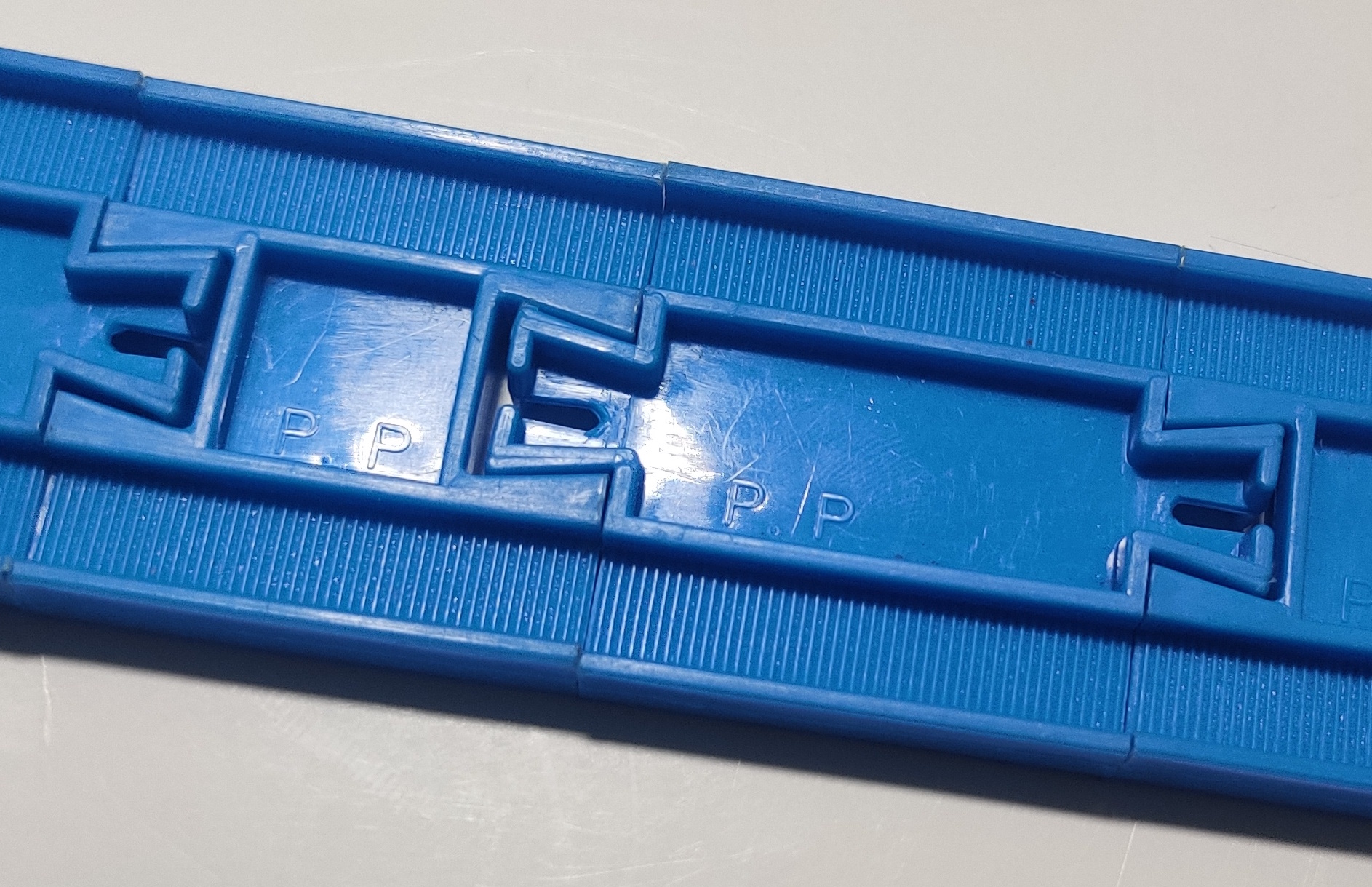
These later joint rails were referred to as R-10 ジョイント. These original joint rails remained in production for the Japanese market until 1997 after the new 1/4 Straight Rails were introduced in 1996, briefly coexisting. In 1998 R-10 became the now iconic red U-Turn Rail.
7482 Adaptor Rails (Tomica World) (1998)
In 1998 after regular production for Japan had ceased the old odd-length joint rails were released in a twelve pack like the Plarail release for the export Tomica World range as 7482 Adaptor Rails. These were Thailand-made P.P. rails and continued to be made into the mid 2000s, getting a Thomas Motor Road & Rail rerelease in 2003. The new quarter-length tracks were also sold under the Tomica World range mail-order from Tomy, and they later also got a Thomas packaging release.
R-20 1/4 Straight Rail (1996)
| <-- R-19 Automatic Turnout Rail | R-21 Double Curve Rail --> |
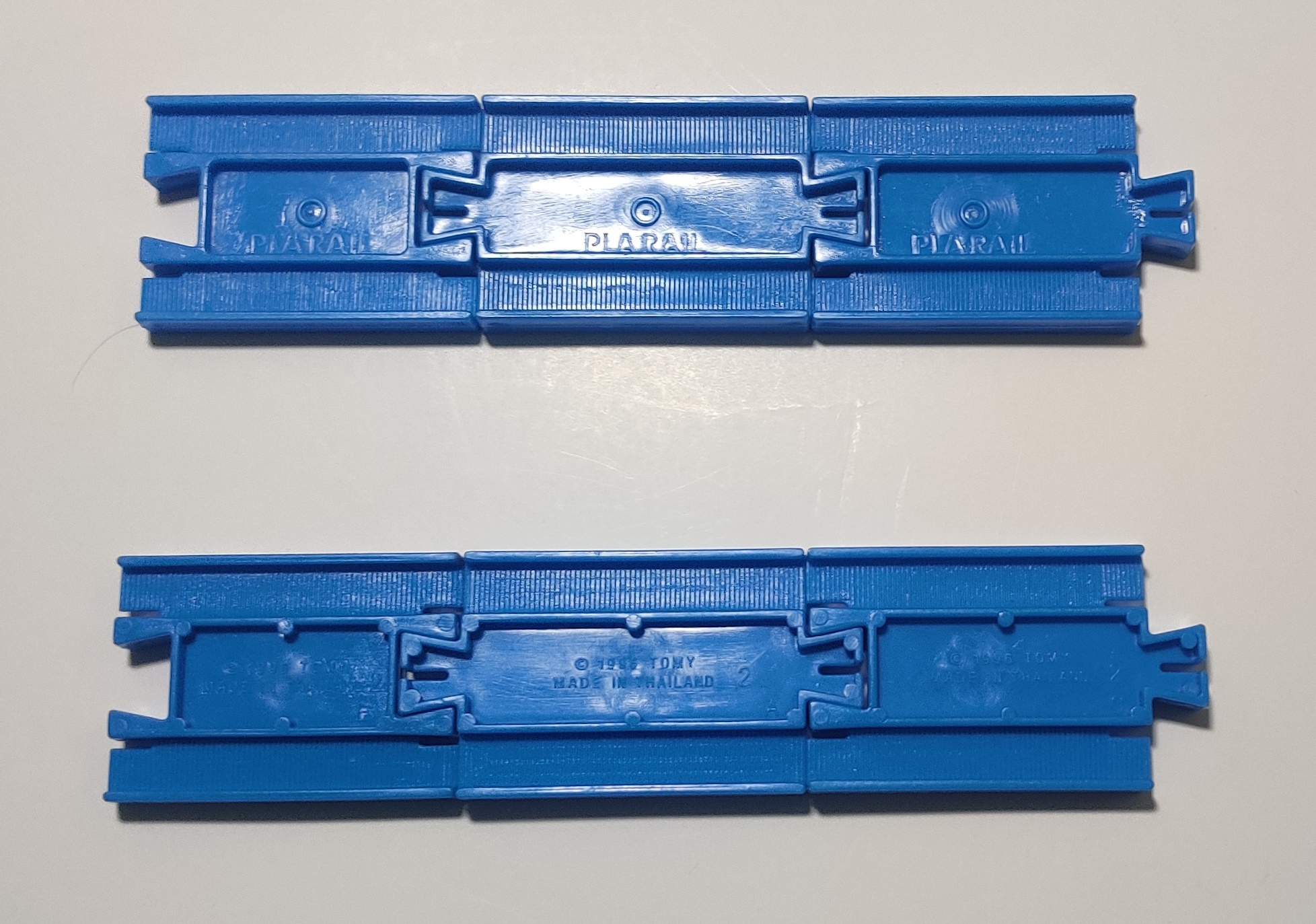
In 1996 a new style of joint rail measuring 1/4 of a normal straight rail was introduced alongside a 1/4 true straight rail. These straight rails are slightly undersized but with the play inherent in the Plarail rail system they work out fine and can be used in many ways. The individual R-20 release is a nine-pack that includes three each of double concave, double convex, and normal straight rails.
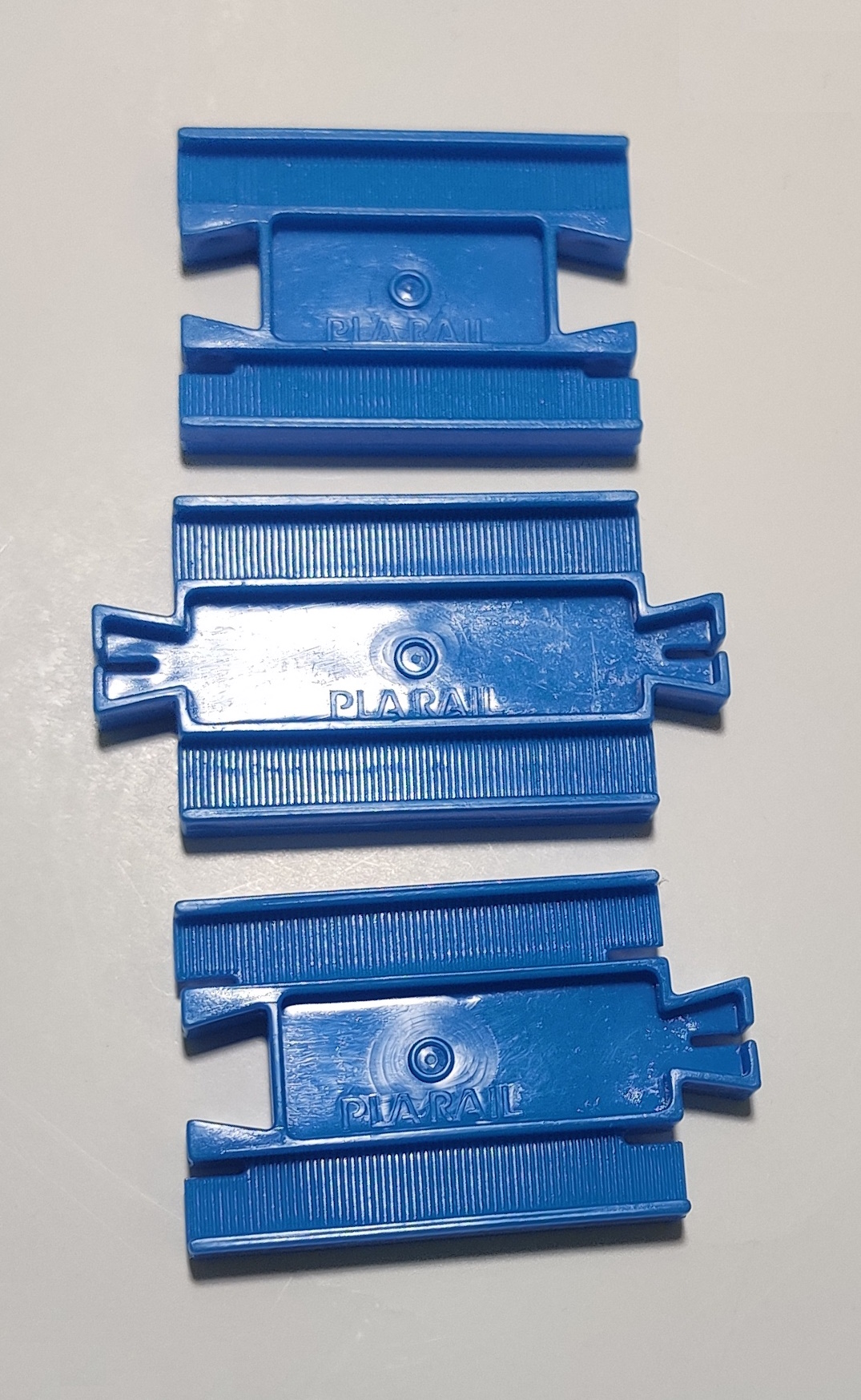
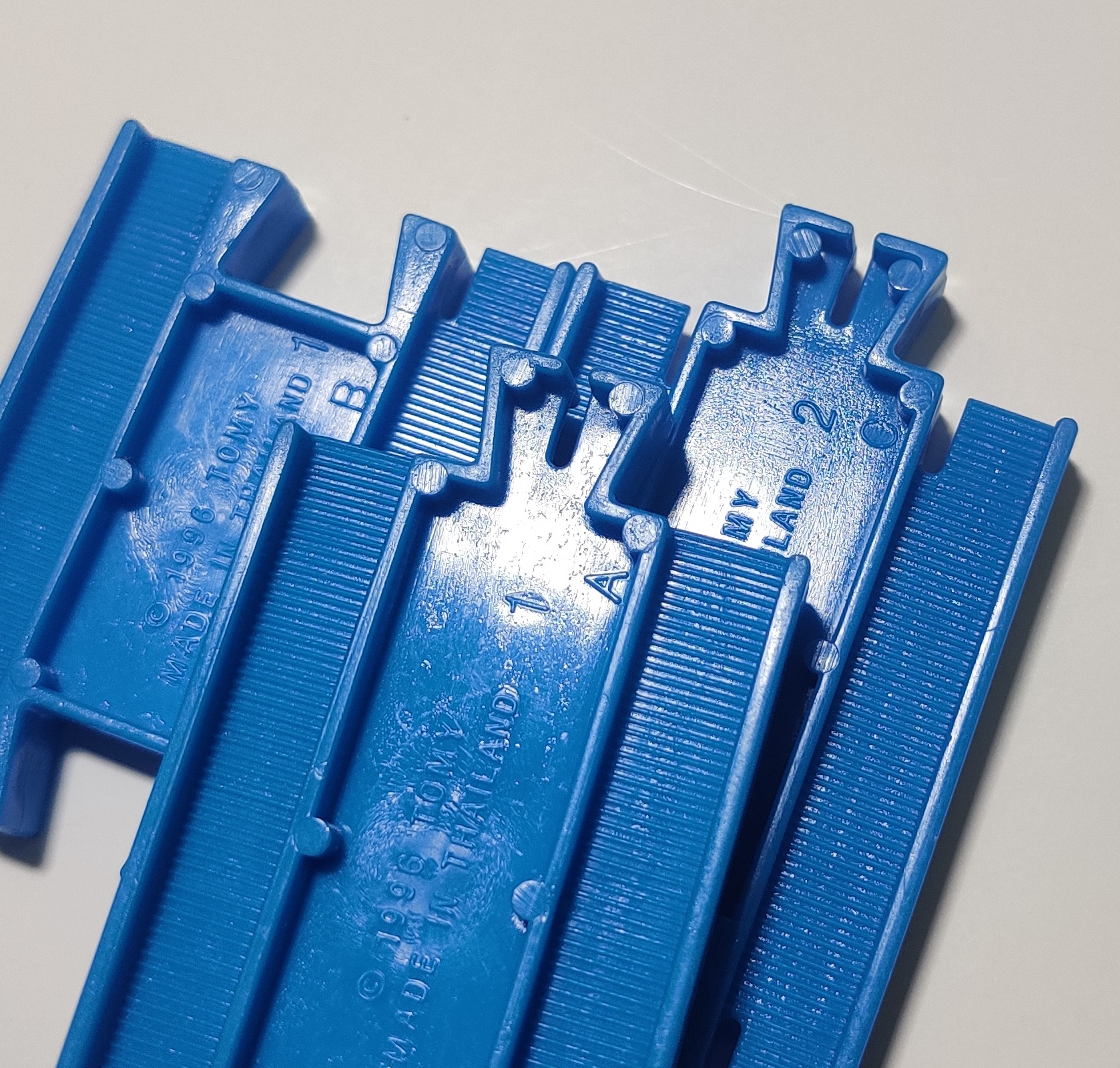
Early 1/4 Straight Rails have the Plarail name on the top like some other new track toolings from the time. They are marked 1996 Tomy Made in Thailand and have molding slot marks. The double convex rail is marked A, the double concave B, and the normal straight C. Some of these rails were exported in earlier Tomica World sets and still bear the Plarail text.
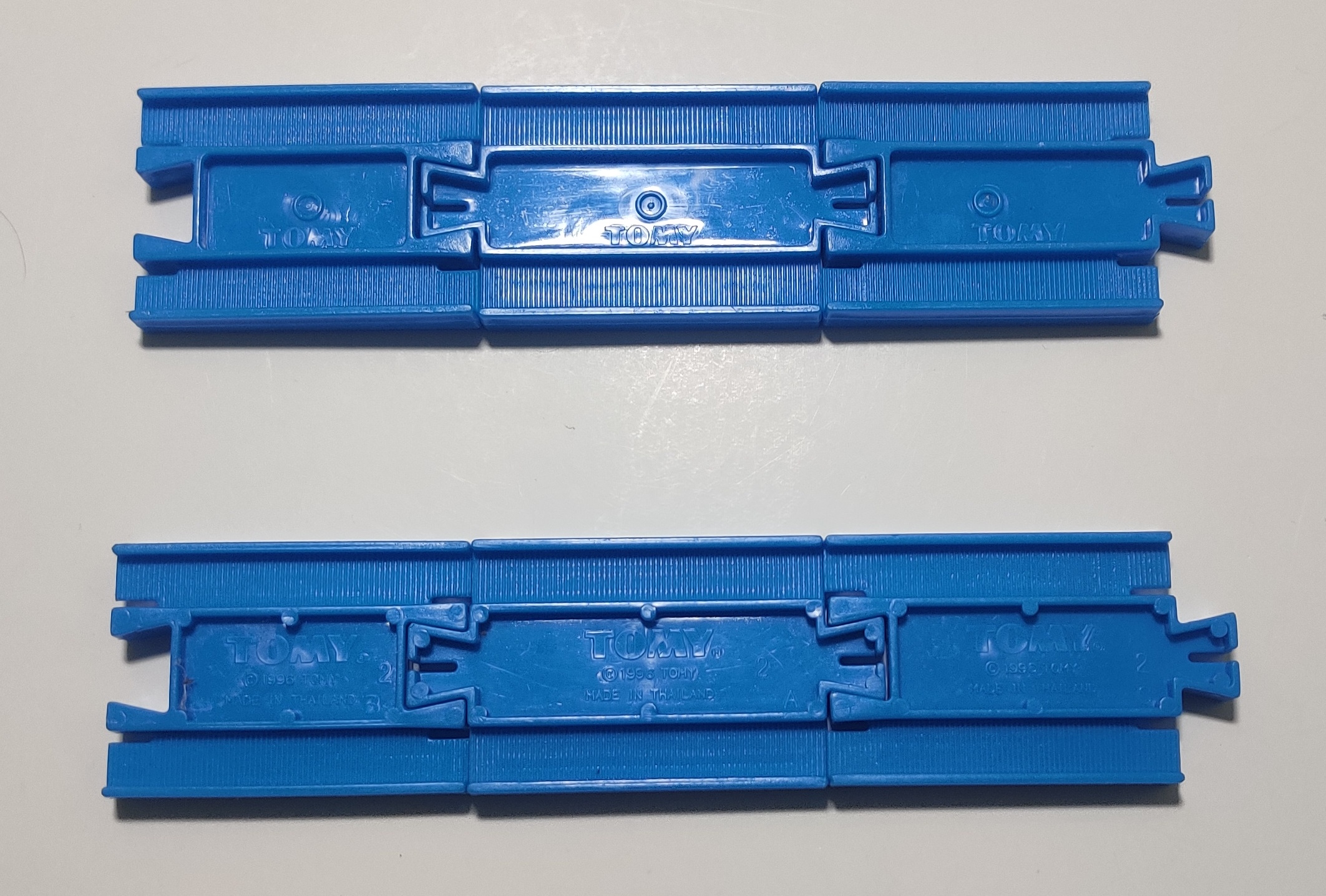
In the 2000s the 1/4 Straight Rail tooling was updated with the new squared off Tomy logo.

These rails were still dated 1996 on the bottom with other similar molding marks.
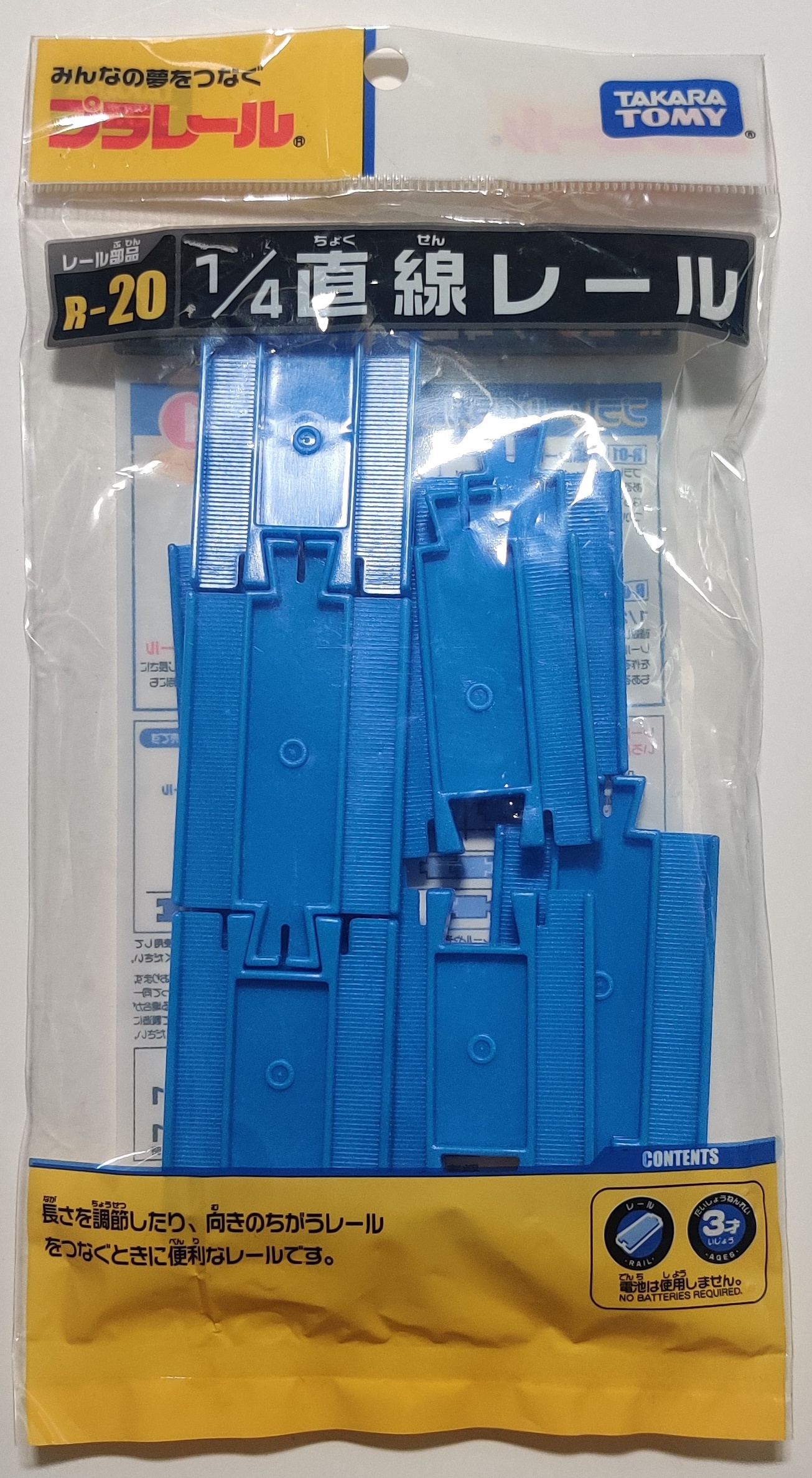
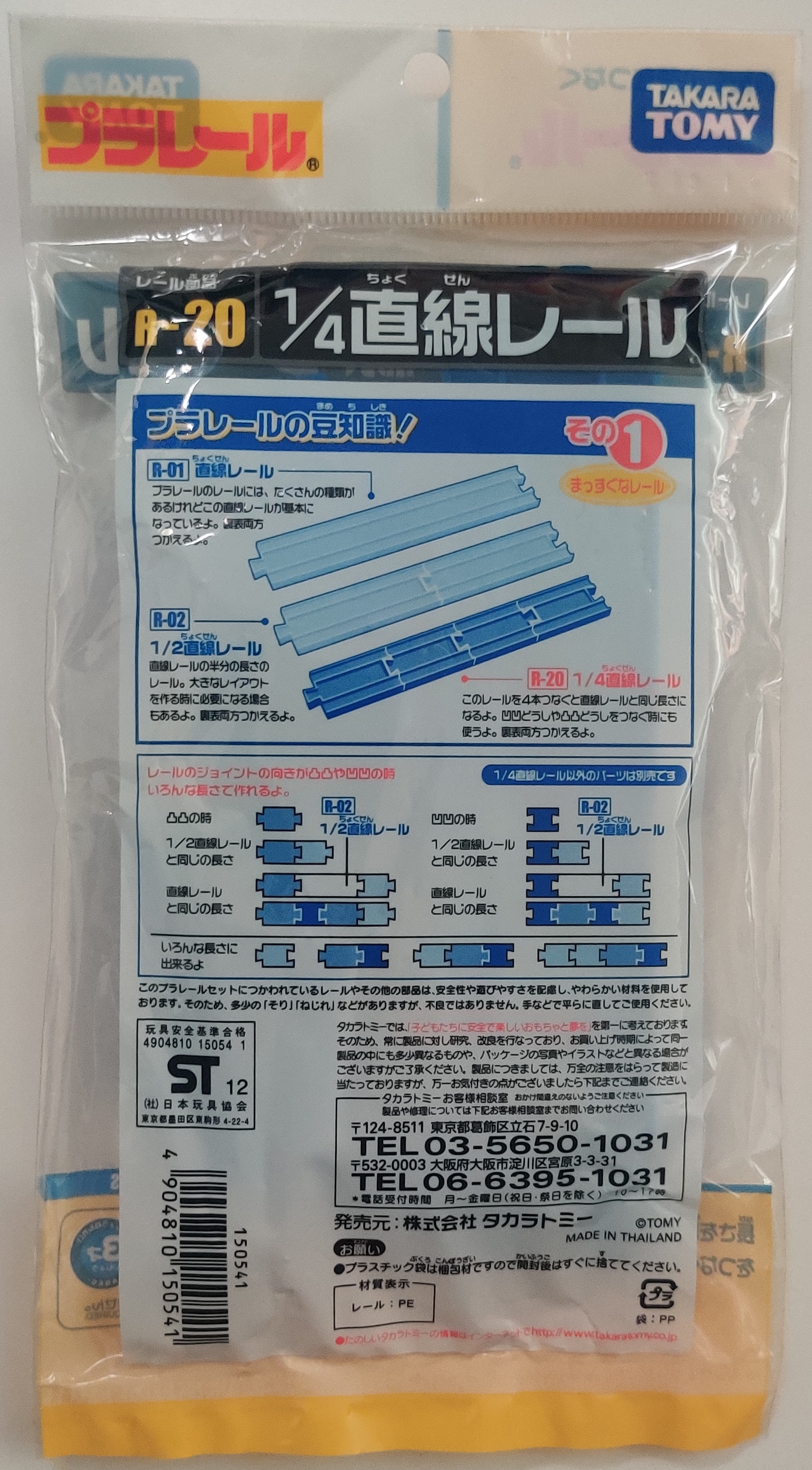
Quarter Straight Rails continued to be produced in Thailand into the early 2010s, with the large logo being removed from the "top" of the rail later on. The rear of the bag shows how the rail fits in geometrically with other rails and how to produce double concave or convex pieces of varying lengths. This sealed bag came in a larger lot of Plarail, and as I have no reason to open it, I have not done so (this is generally my rationale for deciding if I should open sealed toys - If I do not have a reason to open it, I generally won't. I have plenty of loose joint rails).
In more modern times, Tomy has moved production of some Plarail from Thailand to Vietnam. In some ways, it seems to mirror the move from Japan to Thailand in the late 1980s and early 1990s. I have not deeply explored this transition yet, as it occurred after when my main area of interest in Plarail is - generally, before the 2003 brand refresh, although I generally think the 2000s products are also perfectly fine, and it was mostly in the mid-later 2010s and now 2020s that Plarail has started to become less impressive in some ways.
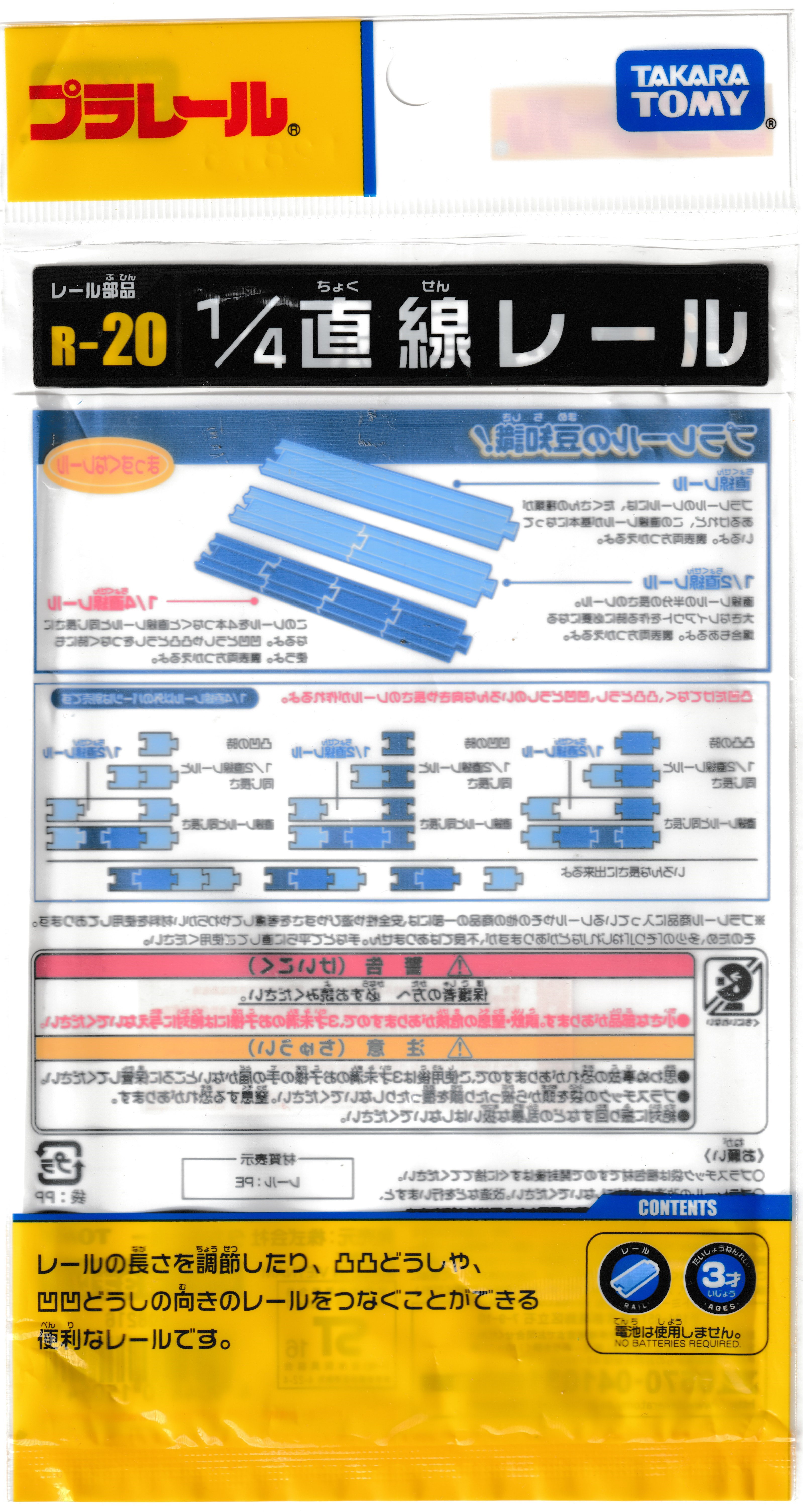
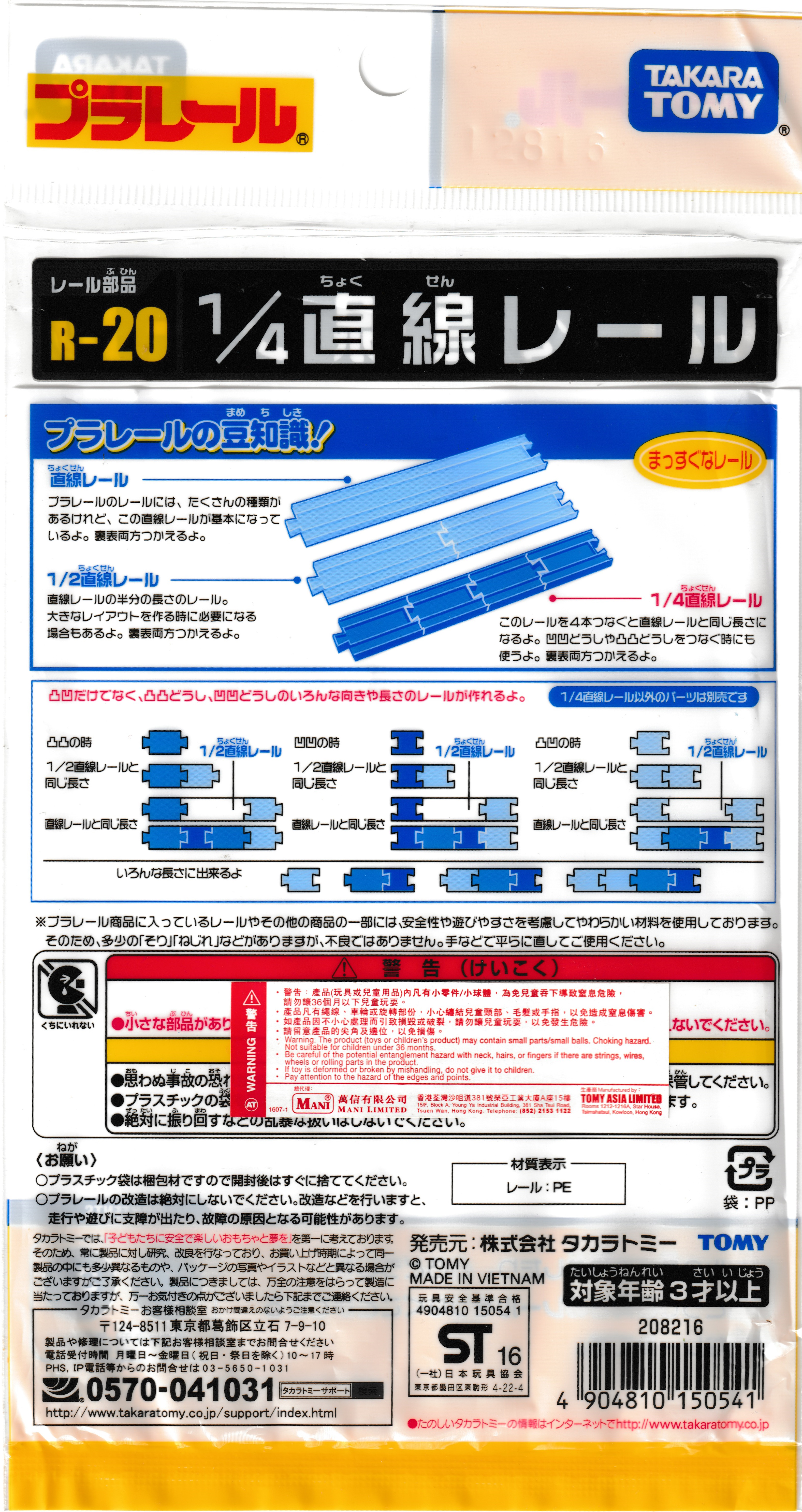
All that aside, rail is rail, and when I was just starting out buying Plarail in around 2017 I purchased some quarter straight rails online as I had no kinds of joint rails. The ST mark on the bag dates these rails to around 2016. I believe the Tomy Asia Limited sticker on the back means at some point these rails were exported for the Hong Kong/Asia region as some Japanese Plarail has been for some time.
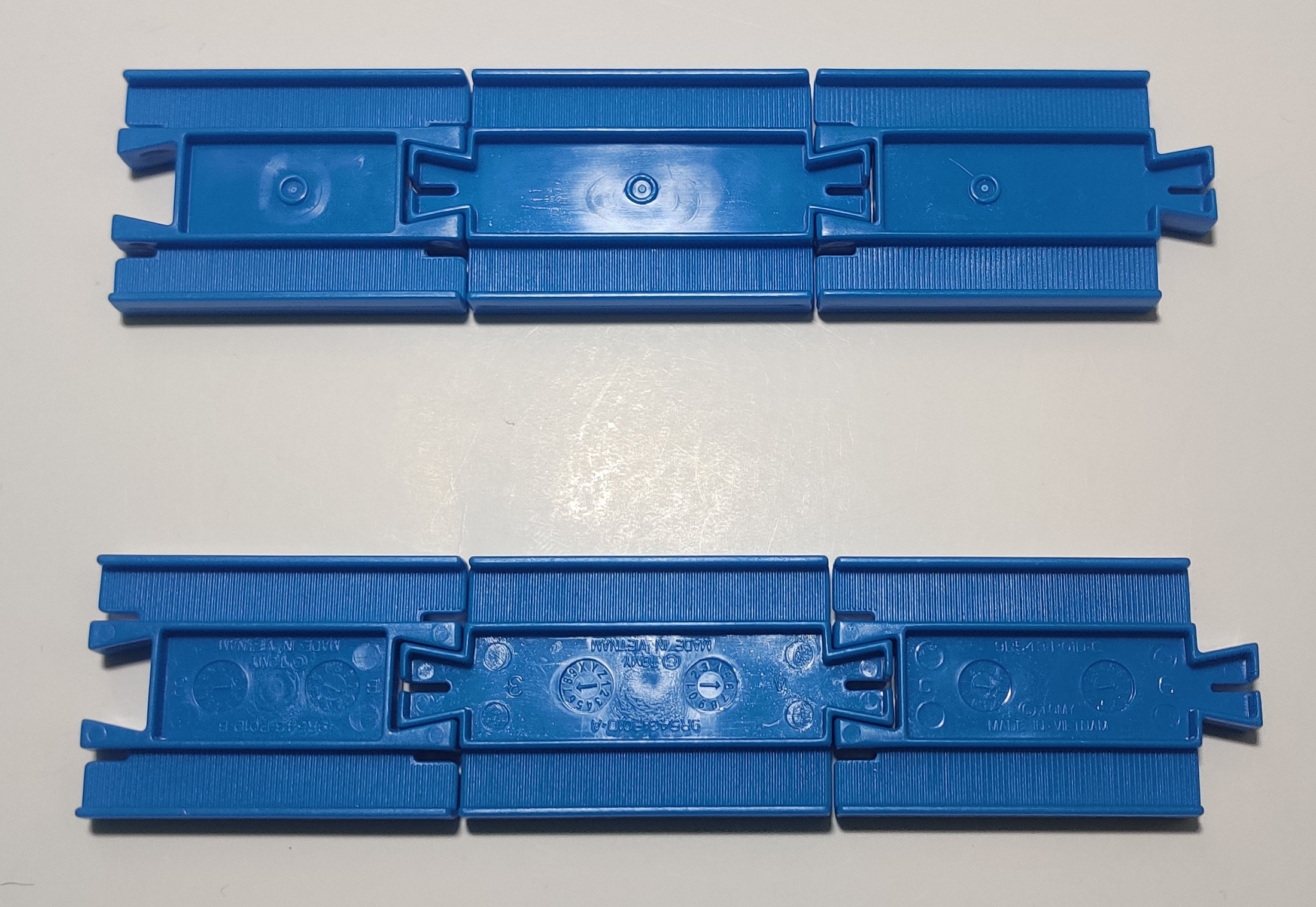
These Vietnam-made quarter straights have a ringed pip like the previous late Thailand era ones and have dial molding marks in the bottom.
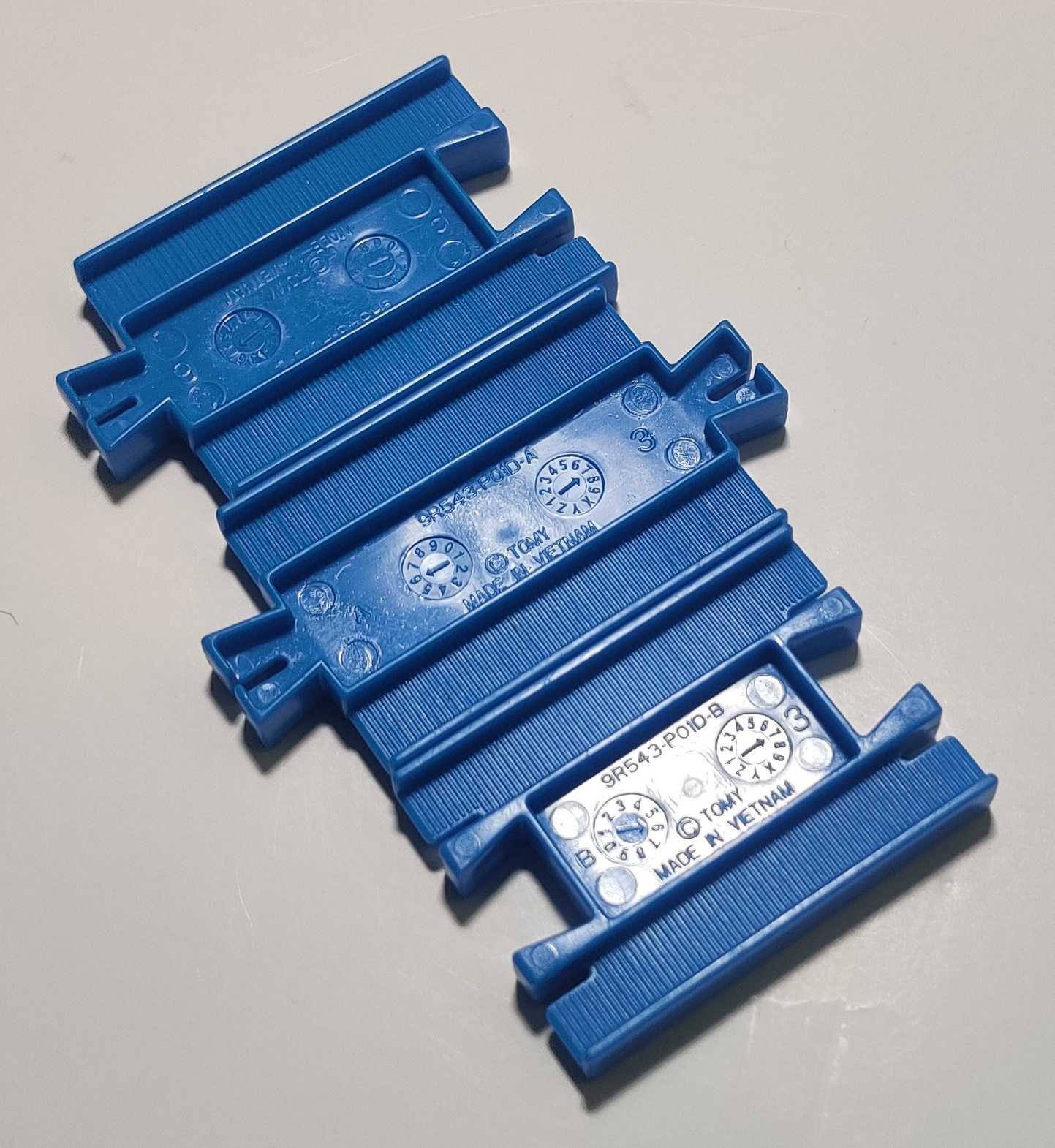
They have a more complicated production code on the bottom as well as the slot mark and type letter as before plus the dial markings.
7495 Quarter Straight Rails (Tomica World) (1999)
In 1999 packs of three of each kind of quarter straight rail began being sold mail-order from the Tomy Careline for the export Tomica World range. In 2003 they were released generally in Thomas Motor Road & Rail packaging. Examples purchased from the Careline in the 1990s would have been the early Plarail tooling type, and these Plarail marked quarter straights also came in a handful of Tomica World sets which needed them like the Thomas Giant Set.
Different combinations of these two types of rail can produce many different lengths of track, especially over long distances or when filling in areas on a layout with many joints that can shift to accommodate a range of lengths.
"Bean" joint rail (early 1970s)
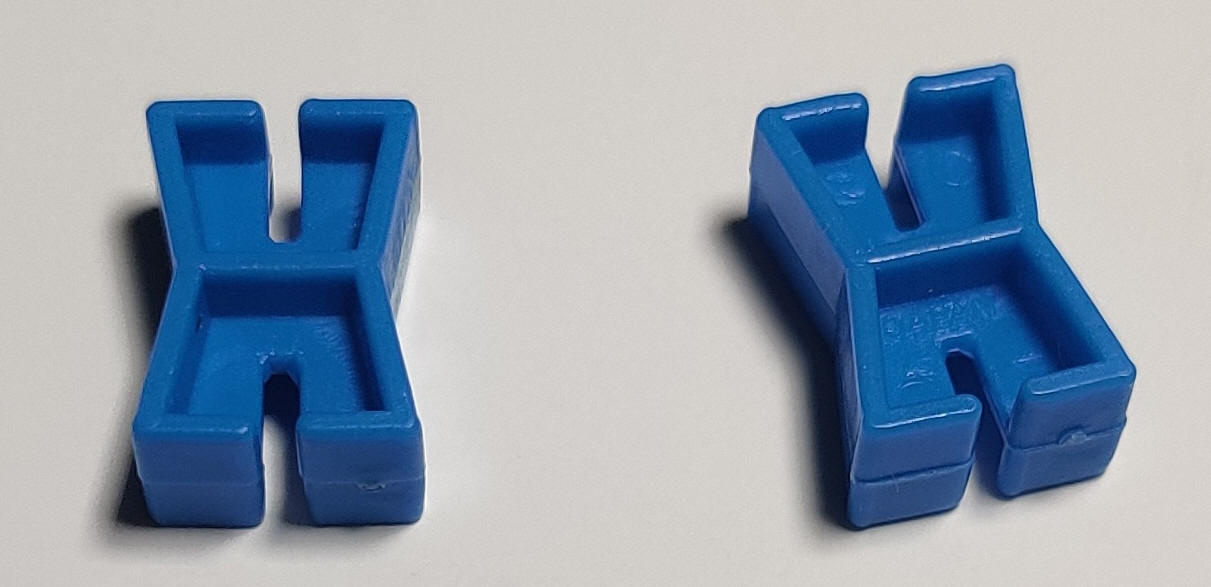
Included with some accessories, typically ones with concave connectors on multiple ends, were these 0-length double-convex joint pieces that allowed the concave connectors on most track and many accessories to be directly connected.
Depending on the age of the rails and the design of the convex connectors on accessories, these joints can be used in many places. Admittedly, many places will also work with the other types of joint rail, but these offer a unique option. In practice, these continued to be called joint rails, with Japanese collectors sometimes referring to them as "beans," similar to how the equivalent pieces from wooden train sets are sometimes called dogbones.